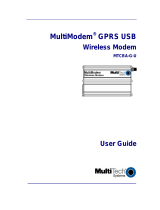
Contents
5 MultiModem® iSMS Administrator’s Guide
Save & Restart .......................................................................................................................................................... 60
Utilities ................................................................................................................................................................. 61
Utilities > Backup...................................................................................................................................................... 61
Utilities > Firmware Upgrade ................................................................................................................................... 62
Import & Export Address Book .............................................................................................................................. 63
Import & Export Address Book > Import .................................................................................................................. 63
Import & Export Address Book > Export .................................................................................................................. 66
Statistics & Logs .................................................................................................................................................... 67
Statistics & Logs > System Information .................................................................................................................... 67
Statistics & Logs > SMS Statistics ............................................................................................................................. 68
Statistics & Logs > Load Balancing Statistics ............................................................................................................ 69
Statistics & Logs > Log Traces ................................................................................................................................... 70
Chapter 5 – Using the Non-Administrative User Interface ............................................................................ 71
Web Interface Available to Non-Administrative Users ........................................................................................... 71
How Non-Administrative Users Login ...................................................................................................................... 71
Chapter 6 – SMS Examples ........................................................................................................................... 73
Verifying the SIM Card is Installed and Activated .................................................................................................. 73
Creating a Broadcast Message for Future Use ........................................................................................................ 75
Appendix A – Application Programming Interface (API) ............................................................................... 76
Acronyms and Definitions ........................................................................................................................................ 76
SMS API ................................................................................................................................................................ 77
HTTP API ................................................................................................................................................................... 77
TCP API ..................................................................................................................................................................... 93
Receive SMS API ................................................................................................................................................... 97
Non Polling Mode Receive SMS API ......................................................................................................................... 97
HTTP Receive API – Non-Polling Mode .................................................................................................................... 98
TCP Receive API – Non-Polling Mode ..................................................................................................................... 100
Polling Mode Receive SMS API ............................................................................................................................... 102
Receive API – Polling Mode .................................................................................................................................... 103
Appendix B – Table of Commonly Supported Subnet Addresses ................................................................. 110
Appendix C – Antennas for the
MultiModem iSMS .................................................................................... 114
RF Specifications ................................................................................................................................................. 114
Antenna Specifications ....................................................................................................................................... 114
GSM/EGSM Antenna Requirements/Specifications ............................................................................................... 114
Antennas Available from Multi-Tech Systems, Inc. ................................................................................................ 114
PTCRB Requirements Note..................................................................................................................................... 114
FCC Requirements Note ......................................................................................................................................... 114
Appendix D – Waste Electrical and Electronic Equipment Directive (WEEE) ................................................ 115
Waste Electrical and Electronic Equipment (WEEE) Directive ............................................................................... 115




















